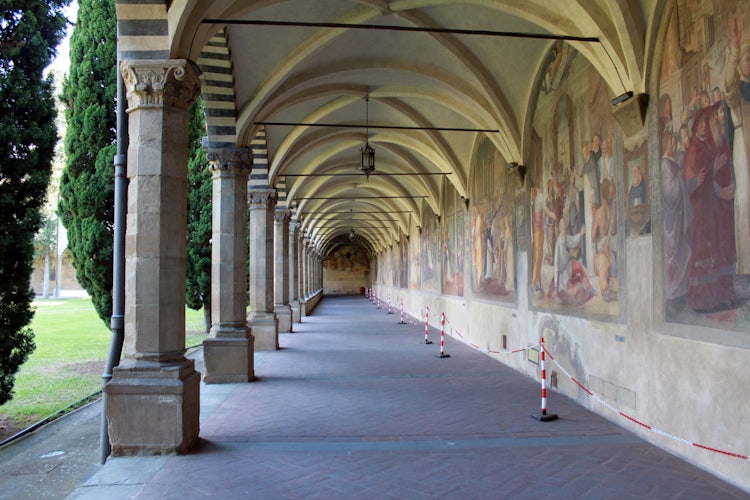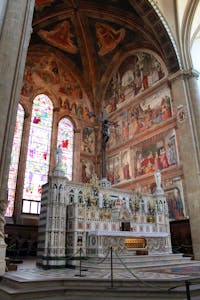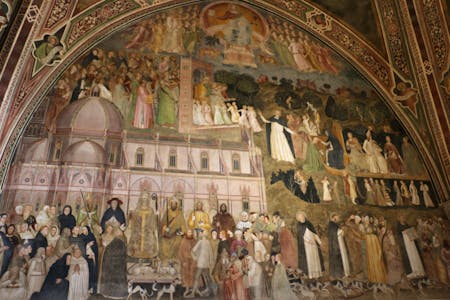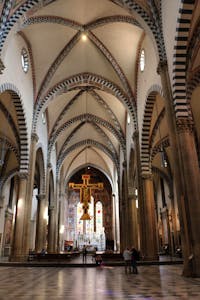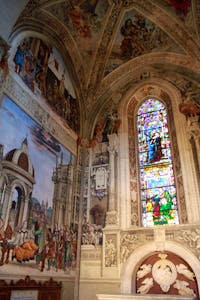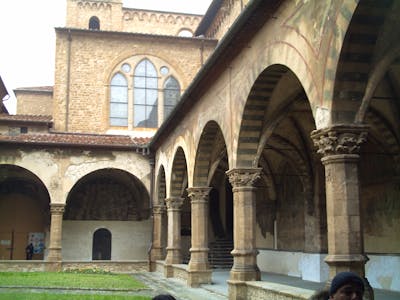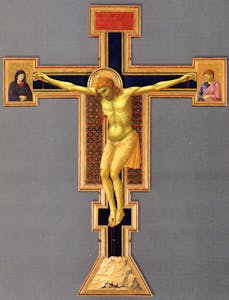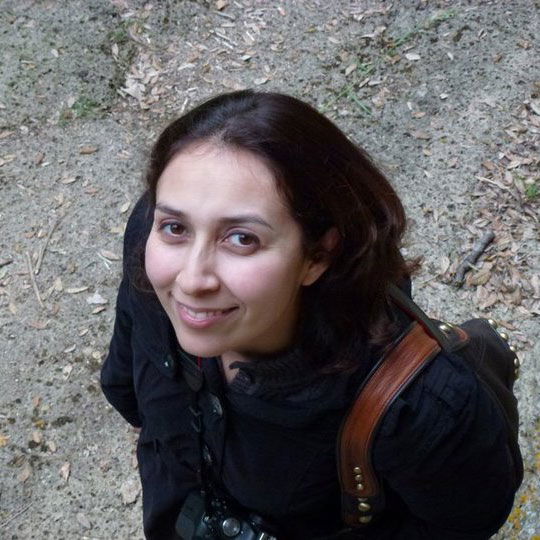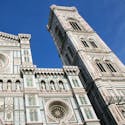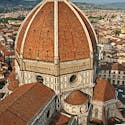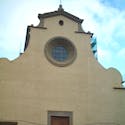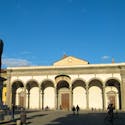One of the most important Gothic churches in Florence
The Church of Santa Maria Novella might not be at the top of your list of places to visit in Florence but we highly recommend you place it on there. Architecturally, it is one of the most important Gothic churches in Tuscany. The exterior is the work of Fra Jacopo Talenti and Leon Battista Alberti. The interior holds extraordinary works of art including Masaccio's Trinità, Ghirlandaio's fresco cycle in the Tornabuoni Chapel and Giotto's Crucifix, among others.

The convent was built between 1279 and 1357 by Dominican friars near a 7th century church located in the fields just outside Florence's medieval walls. The lower part of the marble facade, which is Romanesque in style, is believed to have been executed by a Dominican architect, Fra Iacopo Talenti da Nipozzano, while the upper part was completed only 100 years later in 1470 by Leon Battista Alberti. Thus, the facade is not only the oldest of all the churches in Florence but it is also the only church with its original, planned facade still in place today! As you will see, the church of San Lorenzo never even received its planned marble facade while others were completed centuries later... but with new designs.
What to see inside
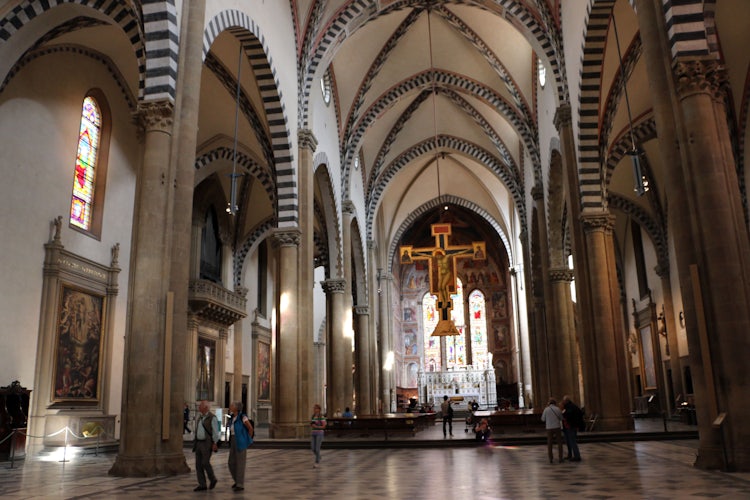
Inside, the church is vast and looks even longer than it is thanks to the clever coloring of the central arches. The layout is supposed to be work of Brunelleschi, the same architect of the Duomo's cupola.
From the very beginning, great works of art were conceived for the church by masters such as Masaccio, Giotto, Filippino Lippi, Duccio di Buoninsegna and Ghirlandaio, just to name a few. While some are conserved at the Uffizi today (in particular, Duccio di Boninsegna's Enthroned Madonna and Child), you need to visit the church to see many of these magnificent works of art by some of the greatest artists of our times. Let's start with some of the most important.
Masaccio's Trinity
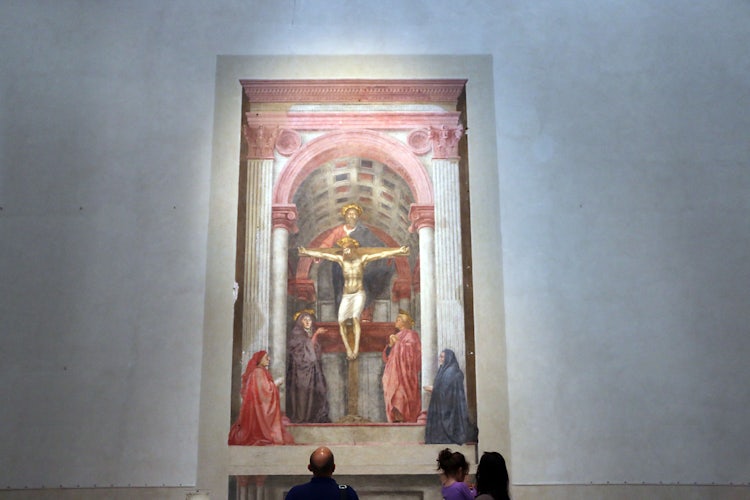
Vasari's changes to Santa Maria Novella
The church initially was divided into two parts: the higher part closer to the altar was divided by a wall and reserved for the friars while the lower part was open to the faithful that entered by the eastern side door. This wall was demolished by Vasari in the 16th century but you can clearly see where the division used to be as Giotto's Crucifix hangs right above. Had you ever wondered why the pulpit is sometimes half way down the church? This division is why: the pulpit is so far down the church because it was in the lower part for the public.
The side door was also closed off by Vasari and was just reopened in 2000 on occasion of the Jubilee celebrations. Having visitors enter through the side entrance today permits us once again to correctly observe Masaccio's Trinity as it was intended.
The Trinità, or Trinity, by Masaccio is on the far wall right in front of you as you enter the church through the side door. The Trinità (1424-25) is one of the earliest paintings to demonstrate mastery of perspective. Also notice that the Virgin Mary is not portrayed as a young girl as in so many other paintings; here, she is older and is clearly a mother.
The entire church was initially covered in frescoes but these were painted over in the 16th century by Vasari when he carried out massive works ordered by Cosimo de' Medici. The Trinità was fortunately only covered by a massive painting and actually "rediscovered" around 1860 when further refurbishments were carried out.
Giotto's Crucifix
The Crucifix by Giotto hangs in the center of the central nave as all his crucifixes were intended (you can see it in the picture posted earlier): with empty air all around it, you were to be reminded of Christ's actual crucifixion on the wooden cross. While it is an early work (1288-89) for Giotto, you can see his mastery in the shading on Christ's body, the waves in his hair, the blood spilling out, the details in the background tapestry. Gorry but BEAUTIFUL at the same time!
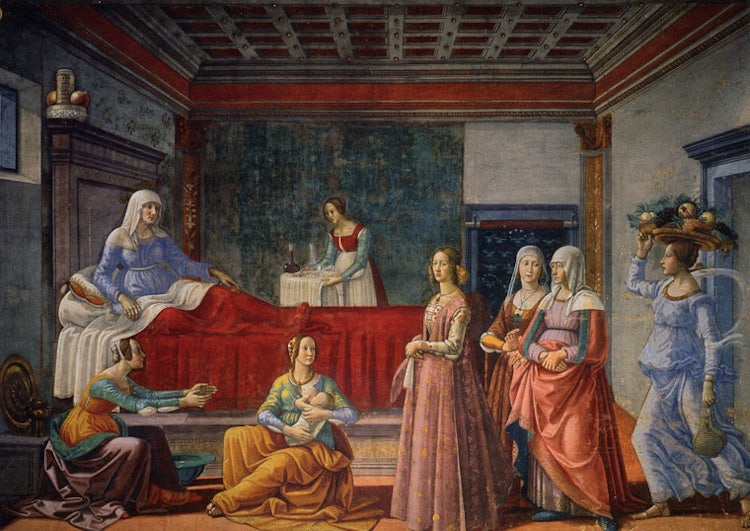
The Strozzi Chapel
The Strozzi Chapel, to the right of the main altar, is dedicated to St. John the Evangelist and scenes of his life are portrayed in the beautiful frescoes by Filippino Lippi. He begun working on the chapel in 1487 but then the Strozzi were exiled from Florence by the Medici. The chapel was finished only in 1502 after the Strozzi returned to the city. As Lippi dies in 1504, this is one of his last works.
The Tornabuoni Chapel by Ghirlandaio and his Workshop
The Tornabuoni Chapel is the main chapel you see at the front of the church, right behind the main altar which today sort of hides it. The altar actually used to be smaller and placed in the center of the chapel but was enlarged in the 19th century with the large engraved marble altar we see today.
The Tornabuoni chapel is dedicated to both the Virgin Mary, to whom the church is dedicated (scenes on the left), and to St. John the Baptist (scenes on the right). The frescoes are by Domenico Ghirlandaio and his workshop, in which a very young Michelangelo was apprenticed. The three young lads giving their backs to the observer in the bottom right scene "Mary visits Saint Elizabeth" are said to be his work. After restoration, the vibrant colors are still stunning and Ghirlandaio's penchant for including important people of the day in contemporary clothing make his work to be actual "photographs" of his days. The beauty of his work has to be personally admired to be fully appreciated.
See more pictures of the frescoes inside the Tornabuoni chapel »
Brunelleschi's Crucifix

The Gondi chapel to the left of the main altar contains a wooden Crucifix by Brunelleschi from 1410-15 which he completed in competition with his friend Donatello. Brunelleschi saw the crucifix Donatello had created for the Bardi Chapel in Santa Croce and was said to have exclaimed that Donatello's Christ looked like "a farmer on a cross" and said "I'll show you how Christ is supposed to be". He said that Christ was a man but not just any particular man and Brunelleschi then set out to show what he meant by that. The result is this Crucifix: carved in wood and then painted, observe the beautiful, majestic inclination of the head and the realistic detailed carving of the muscles in His body.
The Strozzi di Mantova Chapel
The Strozzi di Mantova Chapel (left transept) is dedicated to St. Thomas Aquinas and decorated with frescoes (1351-7) by Nardo and Andrea di Cione depicting Paradiso e Inferno, Paradise and Hell. Dante himself is represented in the Last Judgment just behind the altar. The polyptych is by Andrea di Cione, called the Orcagna. Orcagna had originally done frescoes in the main Tornabuoni chapel but these were painted over by Ghirlandaio; after restoration of the Ghirlandaio frescoes, some synopses of Orcagna's original frescoes were recovered and today can be seen in the museum in the small cloisters right next to the church.
The Nativity by Botticelli and the Pulpit by Buggiano
The Nativity scene by a young Sandro Botticelli is from about 1475 and is now on the inner wall of the facade above the main door. It was placed here after the fresco was found in 1860 behind another altar painting.
The pulpit has 4 beautiful bas-reliefs by Buggiano, Brunelleschi's adopted son. The first one, the Annunciation, is said to be particularly lit by a direct ray of light passing through the round stained glass window on March 25, the day of the Annunciation which for centuries was considered the start of the new year on the Florentine calendar.
These are just some of the major works of art for which you should visit the basilica of Santa Maria Novella. There are many other decorations and details to be admired within so enjoy your visit!
The Small Cloister & Refectory
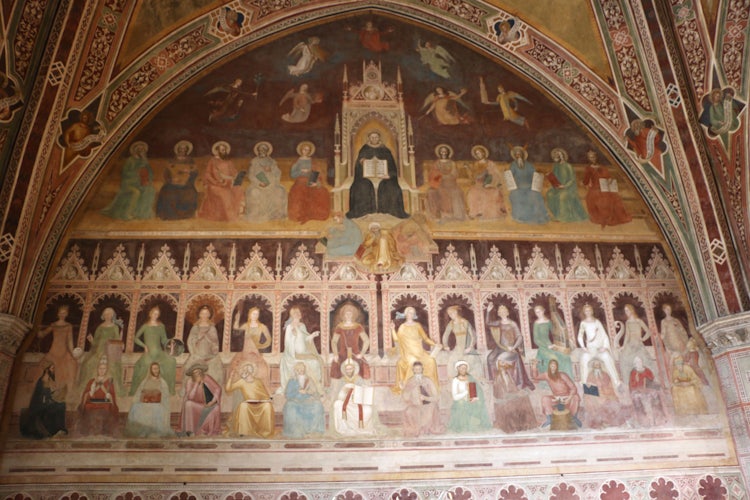
The museum is composed of the two first cloisters of the ancient convent, the Spanish Chapel and the large refectory. The first, the Green Cloister, has frescoes by Paolo Uccello with scenes from the Old Testament on 3 of the 4 sides and, being outside, some are in bad shape but can still be admired.
Continue on to the magnificently decorated Chapter House, called the Cappellone degli Spagnoli or Spanish Chapel ever since it was used by the courtiers of Eleanor of Toledo, wife of Cosimo I. The chapel features frescoes by Andrea di Bonaiuto depicting Jesus Christ's passion, death and resurrection on the front wall as you enter. To the right, in the Triumph of the Doctrine, the dogs of God (a pun on the word Dominican - domini canes) are sent to round up lost sheep into the fold of the church. To the left, you'll find another fresco by Bonaiuto, the Triumph of the Catholic Doctrine, while the entrance wall frescoes depict stories of the life of St. Peter Martyr.
The tour ends in the ancient refectory where precious liturgical objects belonging to the church's sacristy are on display as well as a few recovered synopses from Orcagna's frescoes in the Tornabuoni chapel.
The Grand Cloister
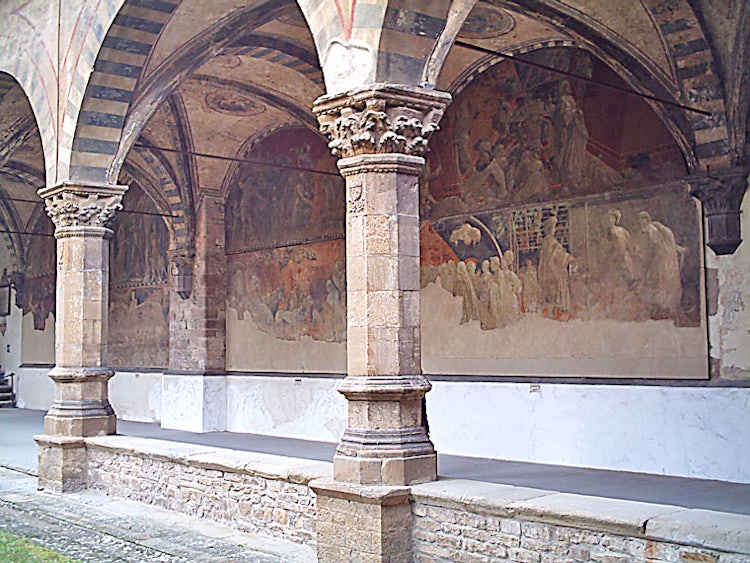
The other cloister, the magnificent Grand Cloister, has been home to the school of Marescialli and Brigadiers of the Carabinieri since 1920, and as such has been closed to the public. The wonderful news in September 2016 is that the new school for the Carabinieri is finally complete and the school is moving out! The spaces occupied by the school will be restored and will be incorporated into the Santa Maria Novella - but no dates have been made public, so for now, the Grand Cloister and other areas remain generally closed.
The Grand Cloister of Santa Maria Novella is called that precisely because it is quite large, with 56 arcades surrounding the internal courtyard corridor. Along one end, it sides with the famous Santa Maria Novella Pharmaceutical and Perfume Laboratory whose entrance is on Via della Scala and on its east side with the Refectory of the Santa Maria Novella museum complex. Another side is the back of the cloister which faces onto the main train station square.
Built between 1340 and 1360, it hosted along three of its four sides dormitories for the friars living here. Two centuries later, two noble Florentine families and the Grand Duke Cosimo I de' Medici financed the decorations of all of the walls with frescoes of the life of St. Domenic and other Dominican saints, scenes from the life of Christ (at the corners) and portraits of important members of the Santa Maria Novella community (on the pilars). The fresco cycle was largely painted within 1570 and 1590 by over 15 various artists from the Accademia known for similar collective works, such as Alessandro Allori, Santi di Tito and Poccetti. The size, iconography and clear narrative style of the scenes make it one of the most representative of the Counter-reformation.
